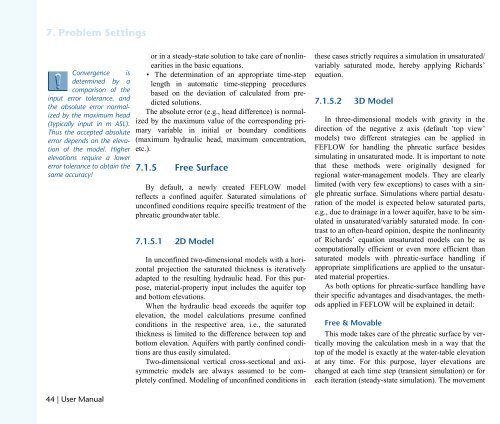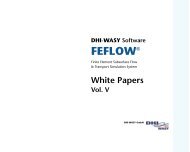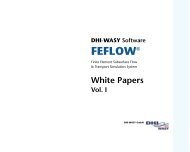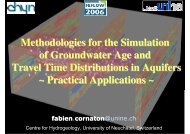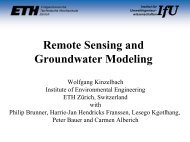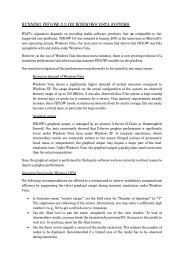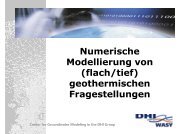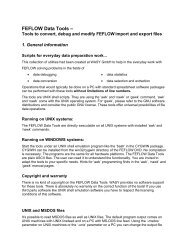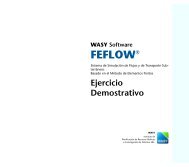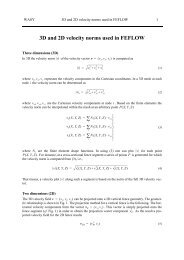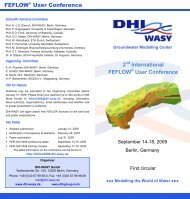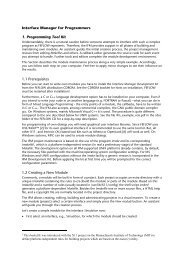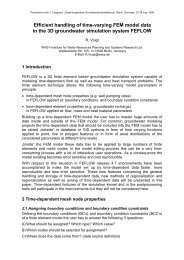DHIJWASv Software FEFLOW 6.1
DHIJWASv Software FEFLOW 6.1
DHIJWASv Software FEFLOW 6.1
Create successful ePaper yourself
Turn your PDF publications into a flip-book with our unique Google optimized e-Paper software.
TK=mêçÄäÉã=pÉííáåÖë<br />
`çåîÉêÖÉåÅÉ= áë<br />
ÇÉíÉêãáåÉÇ= Äó= ~<br />
Åçãé~êáëçå= çÑ= íÜÉ<br />
áåéìí= Éêêçê= íçäÉê~åÅÉK= ~åÇ<br />
íÜÉ= ~ÄëçäìíÉ= Éêêçê= åçêã~äJ<br />
áòÉÇ=Äó=íÜÉ=ã~ñáãìã=ÜÉ~Ç<br />
EíóéáÅ~ääó=áåéìí=áå=ã=^piFK<br />
qÜìë=íÜÉ=~ÅÅÉéíÉÇ=~ÄëçäìíÉ<br />
Éêêçê=ÇÉéÉåÇë=çå=íÜÉ=ÉäÉî~J<br />
íáçå= çÑ= íÜÉ= ãçÇÉäK= eáÖÜÉê<br />
ÉäÉî~íáçåë= êÉèìáêÉ= ~= äçïÉê<br />
Éêêçê=íçäÉê~åÅÉ=íç=çÄí~áå=íÜÉ<br />
ë~ãÉ=~ÅÅìê~Åó><br />
QQ=ö=rëÉê=j~åì~ä<br />
or in a steady-state solution to take care of nonlinearities<br />
in the basic equations.<br />
• The determination of an appropriate time-step<br />
length in automatic time-stepping procedures<br />
based on the deviation of calculated from predicted<br />
solutions.<br />
The absolute error (e.g., head difference) is normalized<br />
by the maximum value of the corresponding primary<br />
variable in initial or boundary conditions<br />
(maximum hydraulic head, maximum concentration,<br />
etc.).<br />
TKNKR cêÉÉ=pìêÑ~ÅÉ<br />
By default, a newly created <strong>FEFLOW</strong> model<br />
reflects a confined aquifer. Saturated simulations of<br />
unconfined conditions require specific treatment of the<br />
phreatic groundwater table.<br />
TKNKRKN Oa=jçÇÉä<br />
In unconfined two-dimensional models with a horizontal<br />
projection the saturated thickness is iteratively<br />
adapted to the resulting hydraulic head. For this purpose,<br />
material-property input includes the aquifer top<br />
and bottom elevations.<br />
When the hydraulic head exceeds the aquifer top<br />
elevation, the model calculations presume confined<br />
conditions in the respective area, i.e., the saturated<br />
thickness is limited to the difference between top and<br />
bottom elevation. Aquifers with partly confined conditions<br />
are thus easily simulated.<br />
Two-dimensional vertical cross-sectional and axisymmetric<br />
models are always assumed to be completely<br />
confined. Modeling of unconfined conditions in<br />
these cases strictly requires a simulation in unsaturated/<br />
variably saturated mode, hereby applying Richards’<br />
equation.<br />
TKNKRKO Pa=jçÇÉä=<br />
In three-dimensional models with gravity in the<br />
direction of the negative z axis (default ’top view’<br />
models) two different strategies can be applied in<br />
<strong>FEFLOW</strong> for handling the phreatic surface besides<br />
simulating in unsaturated mode. It is important to note<br />
that these methods were originally designed for<br />
regional water-management models. They are clearly<br />
limited (with very few exceptions) to cases with a single<br />
phreatic surface. Simulations where partial desaturation<br />
of the model is expected below saturated parts,<br />
e.g., due to drainage in a lower aquifer, have to be simulated<br />
in unsaturated/variably saturated mode. In contrast<br />
to an often-heard opinion, despite the nonlinearity<br />
of Richards’ equation unsaturated models can be as<br />
computationally efficient or even more efficient than<br />
saturated models with phreatic-surface handling if<br />
appropriate simplifications are applied to the unsaturated<br />
material properties.<br />
As both options for phreatic-surface handling have<br />
their specific advantages and disadvantages, the methods<br />
applied in <strong>FEFLOW</strong> will be explained in detail:<br />
cêÉÉ=C=jçî~ÄäÉ<br />
This mode takes care of the phreatic surface by vertically<br />
moving the calculation mesh in a way that the<br />
top of the model is exactly at the water-table elevation<br />
at any time. For this purpose, layer elevations are<br />
changed at each time step (transient simulation) or for<br />
each iteration (steady-state simulation). The movement


